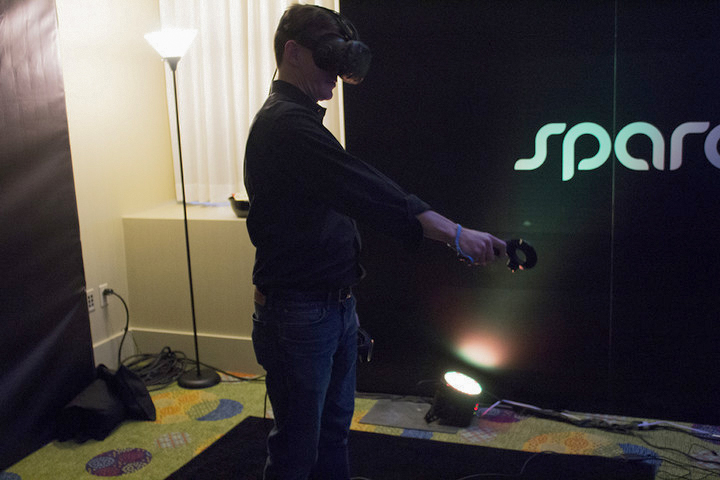
At the 2017 Game Developer’s Conference, CCP Games showed off something very different from what they’ve made before. CCP Games’ next project, Sparc, is a fictitious sport, contrived from the ground up specifically for virtual reality. At its core, Sparc seems more like one-on-one handball or VR pong, but with the overlying objective of nailing your opponent with a high-flying virtual speedball. It has a science-fiction flair about it, but not to the point of alienating the player. In fact, as Godat described it, Sparc is more about physical technique than stats and upgrades.
We spoke with Sparc‘s executive producer Morgan Godat about how the studio made the jump from empowering interstellar strategists, to virtual reality athletes.
The Sparc of a distinctive concept

The idea for Sparc came to CCP Games Atlanta in 2014, when the team comprised of just seven people, before any of the current consumer-grade VR headsets had been released. At the time, VR demos were largely limited to seated experiences, with the player locked to a controller in both hands.
The team prototyped a few different games for that method of play, but the results were considered too similar to what they had previously accomplished with Eve: Valkyrie. Naturally, the developer continued development using Kinect instead, as suggested by the team engineer.
“Be careful, though, if they block the ball, it will be sent back, putting you back on the defensive”
“His reason for plugging in the Kinect into VR development,” Godat told us, “is that he didn’t want to kick his cat while he was working. It was important to him that he could tell what was going on in the room around him.”
It didn’t take long for CCP Games’ Eve: Valkyrie follow-up (which was, at the time, being referred to as Project Arena) to transition from a game that tied players to a chair with an Xbox 360 controller to a Kinect game where all of their surroundings were clearly visible.
Of course, once motion controls became ubiquitous across the Oculus Rift, HTC Vive, and PlayStation VR in 2016, Godat and company proposed a new idea at Eve Fanfest in Harpa, Reykjavik, Iceland.
The team asked fans, “Can we take this game that’s really fun to play with my actual full body in VR and translate it to just those inputs: the motion controllers and the head?” According to Godat, the answer was an enthusiastic “yes.”
Hauling VR back to the basics

Sparc sets itself apart from other VR games by making its mechanics simple and intuitive. Its mechanics are broken down into simple action verbs, gestures you play out using motion controllers. As Godat informed us in our interview, CCP Games started with just a simple core idea; “defend yourself.” Each point of Sparc plays out like a full-body version of ping-pong. One player throws the ball at their opponent. The other has to watch the ball, and either dodge out of the way, or “defend” using shields on his or her knuckles.
“Here’s [sic] your hands, you have your knuckles, just defend yourself from incoming attacks,” Godat said.
If you dodge the ball, then it’s your turn to “throw.” You can throw the ball directly at your opponent, or bounces it off the wall for a tricky ricochet shot. Be careful, though, if they block the ball, it will be sent back, putting you back on the defensive.
According to Godat, “defend” and “throw” came easy to most players, even early on, but the ability to “dodge” is an advanced movement in VR, and it makes the game tough for newcomers.
“What we found in our internal playtest is that initially when people come in and they’re just trying to get their legs underneath them so to speak in VR, they don’t want to have to dodge; they don’t like feeling defenseless; they don’t like feeling like there’s things being thrown at them, that the only action is that [they] have to get out of the way.”
To compensate for this, CCP created two versions of the game, a “rookie mode,” which we saw, and a “pro mode,” which drops the shields and forces players to dodge every throw.
Turning vSports into viewership

Instinctively, when developing a sports game for VR, your first thought might be to replicate a pre-existing sport like football or baseball and appoint it to a headset, complete with 3D-rendered avatars, motion controls, and the like. As Godat was keen to let us know, however, the current limitations of the technology prohibit such effortless conversion.
“We looked at the equipment, and we couldn’t just take a real-world sport and try to put it into VR,” he explained. “It wasn’t that there was a vision for a sport and then we were going to try to put it in VR. That equipment is your sporting equipment. Period.”
“At any given moment, you can look at the field and understand pretty basically where they are in the game.”
He went on to describe tennis, a game that Godat admits heavily influenced many of Sparc’s mechanics. The difference is that with VR the player is tethered to a six-foot play space and, likewise, bound by cables galore.
“It’s not been easy, most sports are based off of large fields, even tennis is a huge space,” he said. “We know we’re not going to have a game where people are just physically running all around, but once those tethers come off, once we start finding different ways to do tracking down the road, we will absolutely be looking at 360 gameplay, tracking a projectile all the way around you in space.”
Being the sport – or “vSport,” as CCP called it in other interviews – that it is, it makes sense that Godat also wants to develop a game that can draw in spectators the same way as PC-based eSports such as Dota 2 or League of Legends, which are often watched as much as they’re played. Cultivating a viewership for Sparc, Godat suggested, will come down to making the game easily digestible for viewers.
“If you look at American football, you have to know what down you are on, what the story was behind that one down; look at this 15-second bite-sized chunk, what is that story? How does that play into the series of downs? How does that play into the possession of the ball? How does that play into the quarter, into the half, and into the game? At any given moment, you can look at the field and understand pretty basically where they are in the game.”
Godat added that not only was Sparc created with the spectator in mind, but it was actually designed for them just as much as it was for the player. The number one focus is gameplay, of course, but ultimately CCP Games said it wants Sparc to be just as enjoyable to watch as it is to play.
From vSports to eSports to every sport in between
To make this possible, CCP turned its head to spectator sports around the world, eyeing what it is exactly that makes them popular. Drawing comparisons to real-world sports, such as American football, Godat brought up former NFL running back LaDainian Tomlinson, citing the moment his feet left the five-yard line and he touched the ground again in the end-zone. “Wow” factors like that inspired how Sparc came to be in its current form.
“It’s the same thing when you see the still-frame photo of Michael Jordan slam-dunking from the free-throw line – this was back when I was a kid, people had that poster on the wall. I think people saw that now, they would look at it and go, ‘Is that Photoshopped?’ No, it wasn’t, he’s physically doing that,” he explained.

When asked about whether CCP Games had any plans to introduce Sparc as an eSport to complement its presence as a spectator sport, Godat likened that idea to making a video and saying it’s going to go viral. “No, not really,” he said. “eSports are built by a community. We aspire to build a game that is good enough that allows for an expression of physical skill that’s high enough that people begin to specialize in it.
“That connection, people watching and seeing those motions and going, ‘I have an idea of what that person must be doing to pull that off’, that’s exactly what we want. We want more of that, we want so much of that. Because it gets people into it, they start to understand more about the sport just by watching it and then they start to feel it instead of being something where you have to educate them.”
Editors' Recommendations
- One year later, my PlayStation VR2 is collecting dust
- Atari is publishing its first VR game, and it’s coming to PSVR2
- PlayStation VR2 will include see-through view and broadcasting options
- Minecraft will add PlayStation VR support this month through free patch
- Why confidence in VR is rising — and Oculus Quest is to thank


